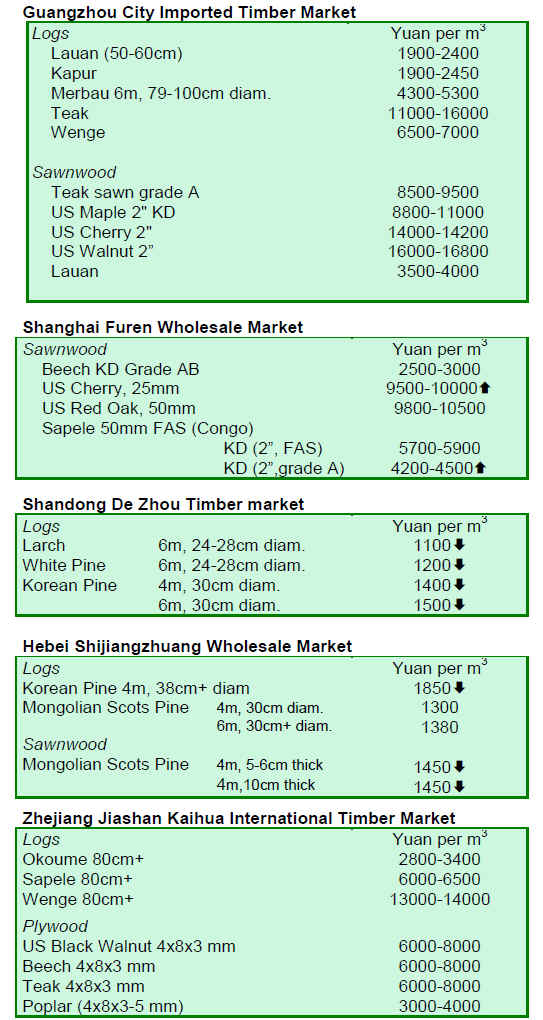US Dollar Exchange Rates of 15th June. 2009
China Yuan 6.8353
Report from China
Chinaí»s annual timber harvest hits an all-time high
Based on the State Forestry Administrationí»s (SFA) 2009
National Timber Production Plan, industrial roundwood
removals in the nation will reach 100.39 million m³ this
year, which is nearly three times as much as the annual
removal before the implementation of the Natural Forest
Protection Programme (NFPP) and an all-time high in
Chinaí»s timber harvest history.
The Plan cites that timber removed from plantations is
72.28 million m³, with removal from natural forests at
28.11 million m³ or 28% by volume. The Plan also shows
that timber removed in the five provinces in South China,
where plantations are dominant, amounted to 48.9 million
m³, representing 48.7% of total timber removed in China.
On the other hand, timber removed in state-owned forests
of Northeast China and Inner Mongolia, where natural
forests are dominant, is only 7 million m³.
Statistical data shows that three favorable changes have
taken place in Chinaí»s timber production practices: (1)
major timber producing areas have moved from north to
south; (2) timber harvests have shifted from natural to
man-made forests; (3) collective owned forests have
become major timber producing sources instead of stateowned
forests.
Timber imports through Zhangjiangang Port recover in
the first quarter of 2008
According to the latest statistics from China Customs at
Zhangjiagang Port, a total of 625 batches with 754,400 m³
of timber valued at USD164 million were imported in the
first quarter of 2009, up 6% by volume and down 10% by
value from the same period of 2008. Of the total imports,
logs were 748,700 m³ by volume, sawnwood 5,700 m³ and
timber in containers 23,400 m³. The chart below shows the
year-on-year change in timber imports through
Zhangiangang Port:

Due to rapid development of surrounding ports, timber
imports through Zhangjiangang had decreased in recent
years. However, since imports have dwindled because of
the economic downturn, timber imports have dropped at
surrounding ports while they have increased at
Zhangjiangang. Africa and Oceania have been the main
supplying sources to Zhangjiangang. Statistics showed
310,500 m³ of African timber was imported in 2009
through Zhangjiangang, rising 10% over last yearí»s
figures. Gabon exported nearly 230,800 m³ through
Zhangjiangang, up 2.8%, accounting for 74% of total
imports from Africa. About 413,900 m³ of timber was
imported from Oceania, up 16% with 319,300 m³ imported
from PNG and 94,500 m³ from the Solomon Islands.
Timber imported in containers dropped significantly.
According to statistics from China Customs, 156 batches
or 23,400 m³ of timber by volume were imported in
containers, valued at USD 9.6 million and down 41.8% by
value from last year. Timber imports from Southeast Asia
fell to an all-time low: 26,900 m³ of Southeast Asian
timber was imported in first quarter, down 56.6%, of
which 21,600 m³ was from Malaysia, and 5,300 m³ was
from Myanmar.
Timber imports from Shuifenhe Port turnaround
According to statistics from China Customs, just over 1
million m³ of logs, accounting for 18.5% of the national
total volume, was imported through the Shuifenhe Port in
first quarter, a fall of 49.6% by volume from the same
period in 2008. However, imports in March dramatically
increased 81.6% to 55,200 m³ over February 2009.
Situated on the border to Russia, Shuifenhe Port has been
one of the biggest collection and distribution centers of
imported Russian timber in China, with average annual
imports being nearly 8 million m³ by volume. However,
affected by the price increase of Russian timber during
2008 and the global financial crisis, timber imports from
Russia through this port fell significantly in early 2009.
Statistics showed that timber imports from Russia jumped
again in March after a long downward trend.
The reasons for this trend are attributed to the following:
(1) the Russian government postponed implementation of
its new export tariff policy which would have taken effect
on 1 January 2009 and (2) to increase imports, the customs
office in Shuifenhe carried out a series of measures to
provide improved services to wood processing enterprises,
such as extending business hours and simplifying custom
formalities.
To cope with the impacts of financial crisis on Chinaí»s
economy, experts suggest the government should
normalize trade and enable enterprises to understand and
respond to changes in foreign policies. It should also
encourage enterprises to move some industries to Russia
and establish an integrated investment system combining
upstream and downstream production.
Guangxií»s forest products industry booms despite market conditions
The forest products industry in Guangxi Autonomous
Region has been booming despite the financial crisis. This
is evidenced by the following:
(1) The output of wood-based-panels has continued to
increase during the financial crisis, with 946,000 m³ of
wood-based panels produced in first quarter of 2009, up
61% over the same period of last year. Eucalypt plywood
for interior decoration also sells well on markets because
of its good quality. Supply has even fallen short of
demand.
(2) Productive capacity of wood-based panels continues to
expand. Nine projects producing wood-based panels with
a capacity of 300,000 m³ and an investment of RMB 200
million yuan have been approved by the Forestry Bureau
of Guangxi. Another four projects with a capacity of
350,000 m³ and an investment of RMB 750 million yuan
remain to be approved.
(3) Outputs of paper and paper board amounted to 135,900
tons, up 61%.
(4) Rosin production jumped nearly 30%, with 22,000 tons
of rosin produced.
(5) The number of closed wood-based-panel enterprises
declined. Only 10 of the 128 plywood mills in Guangxi
stopped production despite the current economic
conditions.

|